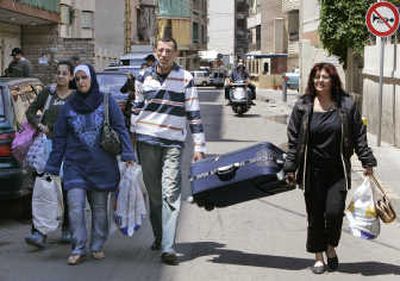Hezbollah flexes muscle, seizes swath of Beirut

BEIRUT, Lebanon – In one swoop, the Shiite Muslim militia Hezbollah took over a large section of Lebanon’s capital Friday, altering the country’s political balance and demonstrating a level of military discipline and efficiency that left the pro-Western government struggling to exert its authority.
In a space of 12 hours the Iran-backed group dispatched hundreds of heavily armed Shiite fighters into the western half of the capital, routing pro-government Sunni militiamen, destroying opponents’ political offices and shutting down media outlets loyal to the government of Prime Minister Fouad Siniora and to Sunni leader Saad Hariri’s Future movement.
Hezbollah did it with a lot of gunfire but minimal damage to infrastructure, although at least 10 people were killed, security officials said. Meanwhile, the Lebanese army largely stood aside, underscoring its reluctance to take sides in a political stalemate that has left the country without a president since November.
The clashes were troubling far beyond Lebanon’s borders. The country, long an arena for competing regional interests, has become one of a number of political and military battlefields where U.S. allies compete against Iran-backed interests. The United States sees the moderate, Western-leaning government as a model for the region; Iran sees the Hezbollah as a major strategic asset.
The White House condemned the Hezbollah move.
On Friday, fighting that had raged for three days in the capital appeared to subside, although more confrontations reportedly flared up pitting Shiite militiamen against Druze and Sunni fighters in other regions. Beirut’s international airport remained closed. Lebanese and foreigners sought to flee the prospect of more fighting by heading across the Syrian border.
On the barren streets of West Beirut, Hezbollah fighters, wearing signature ammo vests and black baseball caps, calmly patrolled streets, napped in the shade and directed traffic, politely stopping some vehicles to ask drivers and passengers for identification cards.
“During lunchtime if you place food on the table, by the time you’ve finished eating, we can take over,” said one veteran Hezbollah fighter patrolling the capital’s famous Hamra Street.
However, few observers expect Hezbollah to try to take over Lebanon or even continue to police West Beirut, especially areas long dominated by its political rivals. The group’s fighters avoided storming government buildings such as the Grand Serail, the Ottoman-era palace that houses the prime minister.
Instead, the offensive was an “object lesson” meant to demonstrate the group’s ability to subdue its domestic rivals quickly without exposing its arsenal of heavy weapons meant to target Israel in a potential war, said Augustus Richard Norton, author of “Hezbollah: A Short History” and a scholar at Boston University.
The current conflict was triggered when the government challenged Hezbollah’s autonomy Tuesday by outlawing the group’s fiber-optic communications network. Hezbollah fighters responded by pushing into the heart of the capital from their strongholds in south Beirut and southern Lebanon, an escalation in the ongoing Lebanese political crisis that seemed to catch the Siniora administration by surprise.
Some of the government’s major political backers appealed Friday night to the international community, the United Nations and other Arab countries for support. The crisis prompted calls for an emergency meeting Sunday among leaders of the Beirut-government’s Arab allies.
“It’s definitely changing the equation,” said Oussama Safa, director of the Lebanese Center for Policy Studies, a think tank. “Hezbollah is reshuffling the cards and redrawing the balance of power.”